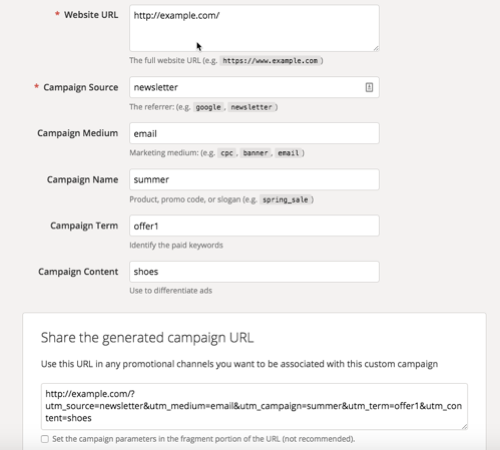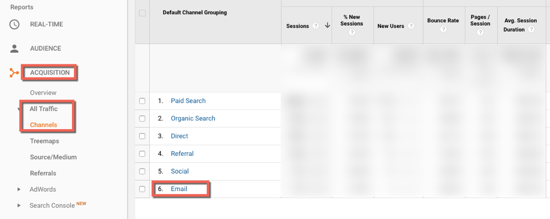A beginner’s guide to email analytics
For email marketing to convert – whether that’s getting more people to read your blog posts, signing up for a live demo, buying a product or service, or contacting you – it has to be done right. And beyond that, it needs to be properly measured.
As a small business owner, you probably wear lots of hats and are in charge of many parts of your business and marketing mix. It’s easy for your email marketing data to get lost in all the metrics and key performance indicators you have to keep an eye on.
But here’s the thing: if you’re not already monitoring the performance of your email campaigns and analysing the data, how can you possibly know what’s working and what could be improved?
In this guide, we’ll show you how to use Google Analytics to track your email campaigns, and which metrics to focus on when evaluating email performance.
But first…
Why is email analytics so important?
A study conducted by VentureBeat of 48,000 companies that use email tools revealed that 32% don’t know which devices their customers are using to open their emails. Also, 29% of the companies aren’t tracking sales made through emails.
That’s huge, considering you can get more revenue with email marketing than almost any other type of marketing. Plus, by monitoring your analytics you can get insights that can help to significantly improve your campaigns and conversions.
So email is a channel that you need to be tracking and optimising if you want to get the best possible results.
But what data should you track, how and where?
Start by using Google Analytics. It’s the most popular tool that gives you access to data on your email campaigns’ performance. But first, you’ll need to set it up.
(If you’ve never used Google Analytics before, check out our guide to installing it here. And if you’d like to learn more about how it works and what other amazing data you can access through it, make sure you take our free Google Analytics training course.)
How to track emails campaigns with Google Analytics
If you don’t take the time to tag your email campaigns properly, you won’t have access to all the data you need to improve future campaigns.
To tag your campaigns, you should either use an email marketing tool that is connected/ integrated with Google Analytics, or tag the URLs in your emails by hand.
To manually tag your URLs, you’ll need to add UTM parameters to the links in your email.
UTM parameters are “tags” that are added to the end of a URL (everything after the “?”), which help to track the effectiveness of a campaign.
Google Analytics uses five UTM parameters that can be added to a URL:
- utm_source – This refers to the source or the site that’s sending traffic to your site. For example, if it’s an email campaign, you can add “newsletter” as a source.
- utm_medium – This refers to the channel you want to track. In this case, the medium is email.
- utm_campaign – This is where you’ll write the campaign name to make it easier to differentiate from other email campaigns.
- utm_term – Mostly used for paid ad campaigns. It allows you to identify the keyword used to trigger the ad. You can also use it in email marketing to identify individual links and can work like a link text summary (e.g. offer1, offer2).
- utm_content – Also most commonly used for ad campaigns. You can use it to mention the size of the banners for example or whatever other detail that’ll help you differentiate and interpret the data.
While the first three are mandatory, term and content are optional.
Here’s how a link with UTM parameters looks:
http://example.com/?utm_source=newsletter&utm_medium=email&utm_campaign=summer&utm_term=offer1&utm_content=shoes
To add the tags to your links, you can either do it manually or use a tool like Google’s Campaign URL Builder (recommended).
With Google’s tool all you need to do is fill out the fields and it will automatically generate the URL which you can then add to your email.
Remember to always check your final links to ensure they work properly. The last thing you want is for subscribers to click an email link and get redirected to a different page than the one you intended or get a 404 not found error message.
If all of this seems overwhelming, remember you can always use an email marketing tool to make things easier.
How to set goals to measure email conversions
An email conversion can be any action that you want your subscribers to take on your website after they’ve clicked on a link in your email. It can be anything from filling out a contact form to downloading an ebook or buying a product on your website.
You can track email conversion by setting up goals in Google Analytics.
To set up a new goal, click on the settings icon in the left corner and then click on Goals, followed by “+New Goal”:
For a more detailed overview of how to set up a Google Analytics goal, check out the Google Analytics support article.
Understanding your email campaign data
After you’ve added UTM tags to your links and sent your email campaigns, the next step is to view the email reports in Google Analytics.
To do this, go to Acquisition -> All Traffic -> Channels and then click on Email for more information.
You can also find data on your email campaigns in the Acquisition -> Campaigns report.
Key email campaign metrics to measure
To measure the success of your email campaigns, here are the most important metrics you need to focus on. The first three metrics we look at will be provided by a good email marketing tool. If you don’t currently have access to these metrics, make sure you switch to a tool that offers them.
- Delivery rate
You want to make sure that people are getting your emails. Because if they’re not, you’re only wasting precious time and resources.
So make sure you monitor the delivery rate of the messages you send. If you discover that your delivery rate is low, it might mean that your messages are being flagged as spam by some email providers.
Things like poor code, bad links or trigger words like “free” or “special offer” in the subject line or inside the email (which are usually associated with disreputable industries) can lead to your messages being marked as spam.
- Open rate
The open rate tells you how many people on your mailing list have opened your email. This is usually expressed as a percentage of the total number of emails successfully delivered, meaning: emails opened/ emails sent – bounces.
Looking to boost your open rates? Check out these ten great tips for improving your email open rates.
- Click through rate (CTR)
This refers to the percentage of email recipients who clicked on one of the links in your email campaign. So, for example, if you sent an email to 200 people and six of them clicked a link, that means the CTR is 3%.
Tracking this metric is very important as it tells you whether people are taking the action you want them to. If they’re not, you might want to consider making a few changes to your emails, including writing more enticing copy, adding catchier images and creating clearer, more enticing calls-to-action.
- Conversion rate
Conversions can mean anything from filling out a form to downloading an ebook, reading a blog post or buying a product. It depends on the action that you’d like subscribers to take in your emails.
You should definitely be measuring conversions after each campaign to see what’s working and what could be improved. As explained above, you can track conversions through Google Analytics by setting up goals.
Wrapping up
Remember that any data is better than none. So start simple by using the information in this guide and leverage the rich data insights of Google Analytics to improve your future email campaigns.
If you want to learn more about email marketing, from how to grow your mailing list and how to run different tests to boost conversions to how to analyse your results, there’s no reason why you shouldn’t take our free email marketing training course.



